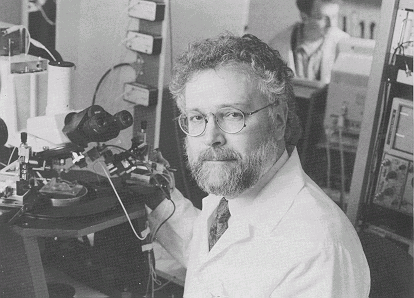


|
|
A team of researchers led by Dr. Larry Jordan are part of an international
effort to regenerate damaged nerve tissue. The discovery of "pace-maker"
cells has led to speculation that it might be possible for a person to regain
the ability to walk after a serious accident.
|
Spinal cord injuries
A team of scientists in Winnipeg is making a name for itself in the field of neuroscience and are at the top of their class in one of the fastest-growing areas in medical research.
These researchers in the department of physiology are interested specifically in studying two major functional systems affected by spinal cord injury or disease: locomotion and bladder control.
"What we are doing in those two areas is attempting to identify which pathways from the brain control these functions and which nerve cells in the spinal cord receive the message from the brain," explains Dr. Larry Jordan, director of the Neuroscience Research Program in the Faculty of Medicine and the Spinal Cord Research Centre of the Health Sciences Centre.
Jordan says this constitutes the most basic research being undertaken in the field at present and is considered essential to understanding tissue regeneration. He notes that this work will have to be completed before efforts to find effective treatments for spinal cord injury or disease can be maximally effective.
Jordan explains that nerve tissue cells are being studied in order to assess whether or not they can be used to promote recovery of locomotion and bladder control through regeneration. The team is taking various approaches to studying what it is exactly that these cells do, and where they are located.
Jordan notes that many factors have contributed to the calibre of work being carried out at the HSC. Monumental efforts by quality researchers and clinicians have resulted in a large contribution to knowledge in the field. Jordan says the work being done is the result of the efforts of several teams, both in and outside Winnipeg.
"There are a number of research programs that are interleaved in such away as to make a product that's more than the sum of its parts," he explains. "It is a collaborative research effort that also includes research teams at the University of Alberta, University of Montreal and British Columbia. There are also teams in Copenhagen and in Tsukuba, Japan, with which we collaborate."
Within the numerous programs funded by a variety of local, national and international agencies and initiatives, the most important research involves efforts to characterize the cells in the spinal cord and brain that control walking and other movement, as well as study the possibility of regeneration in damaged or diseased cells.
"One of the major areas in our research right now is localizing the nerve cells responsible for locomotion by having them take up a fluorescent dye during locomotive activity and then monitoring the activity of the cells," says Jordan.
"Another approach is using chemicals that can activate or excite nerve cells and observing the specific behaviours they cause. This allows us to pinpoint exactly what properties the cells in locomotion possess, and exactly where they are located in the brain and spinal cord."
The efforts of Jordan and his research team have narrowed the possible cells that could have a hand in controlling locomotion. Some of these cells have been found to have so-called pacemaker properties - an intrinsic ability to produce rhythmic activity.
Jordan says the discovery of these conditional bursting cells, as they are called, is an important advance.
"It's a major step forward that has been taken by our group," he says, "to localize the cells and show that they have properties that can account for the rhythmic output associated with walking."
The other major aspect of the research effort is studying the effects of chemicals that have been shown to produce movement in animals with spinal cord injury. Jordan notes that it is possible, in some animals, to stimulate the spinal cord with chemicals that have already been related to locomotion. While it has yet to be shown whether these chemicals can be similarly effective in human beings, he says there are some drug trials under way that are testing the effects of some of these chemicals.
In one of these trials, Dr. Patricia Nance, a rehabilitation medicine expert specializing in spinal cord injury, found that a chemical called baclofen was successful in eliminating abnormal movements such as spasticity in patients with spinal cord injury. Her preliminary work with another chemical has shown that people with relatively minor spinal cord injury who still are able to walk can improve to some degree - they walked faster and in a more coordinated fashion after treatment.
|
|
While the drug trials and cell characterization is promising, he says it is a long way from being applied to everyday treatment of spinal cord injury or disease patients. But Jordan is hopeful.
"I am quite convinced that regeneration of specific spinal cord pathways is possible and that this kind of regeneration can be functionally significant," he says. "So, I wouldn't be surprised if within ten years there were experimental animals with regenerated locomotor pathways. Its already possible to do it in lower animals like lampreys and frogs."
He continues: "An understanding of the basic mechanisms can lead to clinical treatments that are effective. The question is, can we provide chemical treatments that are effective for the restoration of locomotion. We still don't have the answers, but we are learning enough about how locomotion is controlled to be able to test the possibilities."
About NOVUM...NOVUM is a publication of the University of Manitoba public affairs department. Its purpose is to provide information about unique and noteworthy research projects underway at the University of Manitoba.More than 7,000 copies of NOVUM are included in mailings of the Winnipeg Chamber of Commerce and the Manitoba Chamber of Commerce. In addition, it is sent to interested persons in the government, private sector, the professions, the media and others interested or involved in university research. NOVUM is also circulated within the university to more than 5,000 staff members. Readers are encouraged to contact the public affairs department for further information on any of the featured research in this issue.
|
|